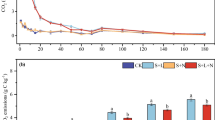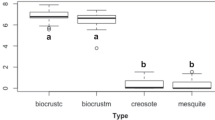Abstract
Free-living N2 fixation is an important pathway of external nitrogen input to natural terrestrial ecosystems. However, few measurements of N2 fixation have been conducted in shrublands. Here, free-living N2 fixation in soil (or soil N2 fixation) and litter (or litter N2 fixation) in three shrublands was measured in a karst catchment, southwest China. The three shrublands were dominated by Pterolobium punctatum Hemsl., Vitex negundo Linn. and Rhus chinensis Mill., respectively. Field measurements were carried out in January and July 2016, respectively, using acetylene reduction assay. N2 fixation had distinct patterns among shrublands or between seasons. In January, no difference was found for soil N2 fixation among the three shrublands, but litter N2 fixation rate was highest in R. chinensis and lowest in P. punctatum. In July, soil N2 fixation rate was highest in R. chinensis and lowest in P. punctatum, but litter N2 fixation was significantly lower in P. punctatum than in the other two shrublands. Across the two seasons, soil N2 fixation rate in R. chinensis was 31% greater than that in P. punctatum, and litter N2 fixation rates in V. negundo and R. chinensis were 13 and 16 times greater than the rate in P. punctatum, respectively. Both soil and litter N2 fixation rates were similar between the two seasons in P. punctatum, but the rates were significantly higher in July than in January in the other two shrublands. Annual N2 fixation rates were estimated to vary from 0.63 ± 0.07 to 0.97 ± 0.08 kg N ha−1 y−1 for the three shrublands. The strongest explanatory variable for soil N2 fixation was total nitrogen in July; and that for litter N2 fixation was nitrogen in January, but was C:N ratio in July. Our findings suggest that large variation in N2 fixation may occur among shrublands within a small scale, and hence, more measurements are needed to get a representative range of N2 fixation rates for the shrubland biome.


Similar content being viewed by others
References
Achat DL, Augusto L, Gallet-Budynek A, Loustau D. 2016. Future challenges in coupled C–N–P cycle models for terrestrial ecosystems under global change: a review. Biogeochemistry 131:173–202.
Barron AR, Wurzburger N, Bellenger JP, Wright SJ, Kraepiel AML, Hedin LO. 2009. Molybdenum limitation of asymbiotic nitrogen fixation in tropical forest soils. Nat Geosci 2:42–5.
Batterman SA, Hedin LO, van Breugel M, Ransijn J, Craven DJ, Hall JS. 2013. Key role of symbiotic dinitrogen fixation in tropical forest secondary succession. Nature 502:224–7.
Broxton PD, Zeng X, Sulla-Menashe D, Troch PA. 2014. A global land cover climatology using MODIS data. J Appl Meteorol Climatol 53:1593–605.
Cleveland CC, Townsend AR, Schimel DS, Fisher H, Howarth RW, Hedin LO, Perakis SS, Latty EF, Von Fischer JC, Elseroad A, Wasson MF. 1999. Global patterns of terrestrial biological nitrogen (N2) fixation in natural ecosystems. Global Biogeochem Cycle 13:623–45.
Cusack D, Silver W, McDowell W. 2009. Biological nitrogen fixation in two tropical forests: ecosystem-level patterns and effects of nitrogen fertilization. Ecosystems 12:1299–315.
Darnajoux R, Zhang X, McRose DL, Miadlikowska J, Lutzoni F, Kraepiel AML, Bellenger J-P. 2017. Biological nitrogen fixation by alternative nitrogenases in boreal cyanolichens: importance of molybdenum availability and implications for current biological nitrogen fixation estimates. New Phytol 213:680–9.
Gundale MJ, Nilsson M, Bansal S, Jaderlund A. 2012a. The interactive effects of temperature and light on biological nitrogen fixation in boreal forests. New Phytol 194:453–63.
Gundale MJ, Wardle DA, Nilsson M-C. 2012b. The effect of altered macroclimate on N-fixation by boreal feather mosses. Biol Lett 8:805–8.
Hardy RWF, Holsten RD, Jackson EK, Burns RC. 1968. The acetylene-ethylene assay for N2 fixation: laboratory and field evaluation. Plant Physiol 43:1185–207.
Houlton BZ, Morford SL. 2015. A new synthesis for terrestrial nitrogen inputs. SOIL 1:381–97.
IUSS Working Group. 2006. World reference base for soil resources 2006. Rome: FAO.
Keuter A, Veldkamp E, Corre MD. 2014. Asymbiotic biological nitrogen fixation in a temperate grassland as affected by management practices. Soil Biol Biochem 70:38–46.
Koller R, Robin C, Bonkowski M, Ruess L, Scheu S. 2013. Litter quality as driving factor for plant nutrition via grazing of protozoa on soil microorganisms. FEMS Microbiol Ecol 85:241–50.
LeBauer DS, Treseder KK. 2008. Nitrogen limitation of net primary productivity in terrestrial ecosystems is globally distributed. Ecology 89:371–9.
Li D, Wang Z, Sun X, Zhang Q, Wang K. 2018a. Tree species effects on asymbiotic N2 fixation in subtropical karst and non-karst forests. Soil Biol Biochem 117:185–90.
Li D, Wen L, Jiang S, Song T, Wang K. 2018b. Responses of soil nutrients and microbial communities to three restoration strategies in a karst area, southwest China. J Environ Manage 207:456–64.
Li D, Wen L, Yang L, Luo P, Xiao K, Chen H, Zhang W, He X, Chen H, Wang K. 2017. Dynamics of soil organic carbon and nitrogen following agricultural abandonment in a karst region. J Geophys Res- Biogeosci 122:230–42.
Li D, Zhang Q, Xiao K, Wang Z, Wang K. 2018c. Divergent responses of biological nitrogen fixation in soil, litter and moss to temperature and moisture in a karst forest, southwest China. Soil Biol Biochem 118:1–7.
Li J, Xiong G, Xu W, Xie Z. 2016. Distribution of shrublands in relation to soil and climate in mid-subtropical China. J Plant Ecol 9:393–401.
Niu S, Classen AT, Dukes JS, Kardol P, Liu L, Luo Y, Rustad L, Sun J, Tang J, Templer PH, Thomas RQ, Tian D, Vicca S, Wang Y-P, Xia J, Zaehle S. 2016. Global patterns and substrate-based mechanisms of the terrestrial nitrogen cycle. Ecol Lett 19:697–709.
Pérez CA, Thomas FM, Silva WA, Aguilera R, Armesto JJ. 2017. Biological nitrogen fixation in a post-volcanic chronosequence from south-central Chile. Biogeochemistry 132:23–36.
Reed SC, Cleveland CC, Townsend AR. 2008. Tree species control rates of free-living nitrogen fixation in a tropical rain forest. Ecology 89:2924–34.
Reed SC, Cleveland CC, Townsend AR. 2011. Functional ecology of free-living nitrogen fixation: a contemporary perspective. Annu Rev Ecol Evol Syst 42:489–512.
Reed SC, Cleveland CC, Townsend AR. 2013. Relationships among phosphorus, molybdenum and free-living nitrogen fixation in tropical rain forests: results from observational and experimental analyses. Biogeochemistry 114:135–47.
Vitousek PM, Hobbie S. 2000. Heterotrophic nitrogen fixation in decomposing litter: patterns and regulation. Ecology 81:2366–76.
Vitousek PM, Menge DNL, Reed SC, Cleveland CC. 2013. Biological nitrogen fixation: rates, patterns and ecological controls in terrestrial ecosystems. Phil Trans R Soc B Biol Sci. https://doi.org/10.1098/rstb.2013.0119.
Wen L, Li D, Yang L, Luo P, Chen H, Xiao K, Song T, Zhang W, He X, Chen H, Wang K. 2016. Rapid recuperation of soil nitrogen following agricultural abandonment in a karst area, southwest China. Biogeochemistry 129:341–54.
Zheng M, Zhang W, Luo Y, Li D, Wang S, Huang J, Lu X, Mo J. 2018. Stoichiometry controls asymbiotic nitrogen fixation and its response to nitrogen inputs in a nitrogen-saturated forest. Ecology. https://doi.org/10.1002/ecy.2416.
Zheng M, Zhang W, Luo Y, Mori T, Mao Q, Wang S, Huang J, Lu X, Mo J. 2017. Different responses of asymbiotic nitrogen fixation to nitrogen addition between disturbed and rehabilitated subtropical forests. Sci Total Environ 601:1505–12.
Zhu J, He N, Wang Q, Yuan G, Wen D, Yu G, Jia Y. 2015. The composition, spatial patterns, and influencing factors of atmospheric wet nitrogen deposition in Chinese terrestrial ecosystems. Sci Total Environ 511:777–85.
Acknowledgements
This work was supported by the National Natural Science Foundation of China (41571295, 41877094), the National Key Research and Development Program of China (2016YFC0502404), the National Key Basic Research Program of China (2015CB452703).
Author information
Authors and Affiliations
Corresponding author
Additional information
Author Contributions
DL designed the study and wrote the original manuscript; QZ and ZW performed the research and analyzed the data; all authors commented on previous version of the manuscript.
Electronic supplementary material
Below is the link to the electronic supplementary material.
Rights and permissions
About this article
Cite this article
Li, D., Zhang, Q. & Wang, Z. Free-living N2 Fixation in Three Karst Shrublands, Southwest China. Ecosystems 22, 818–826 (2019). https://doi.org/10.1007/s10021-018-0305-6
Received:
Accepted:
Published:
Issue Date:
DOI: https://doi.org/10.1007/s10021-018-0305-6




